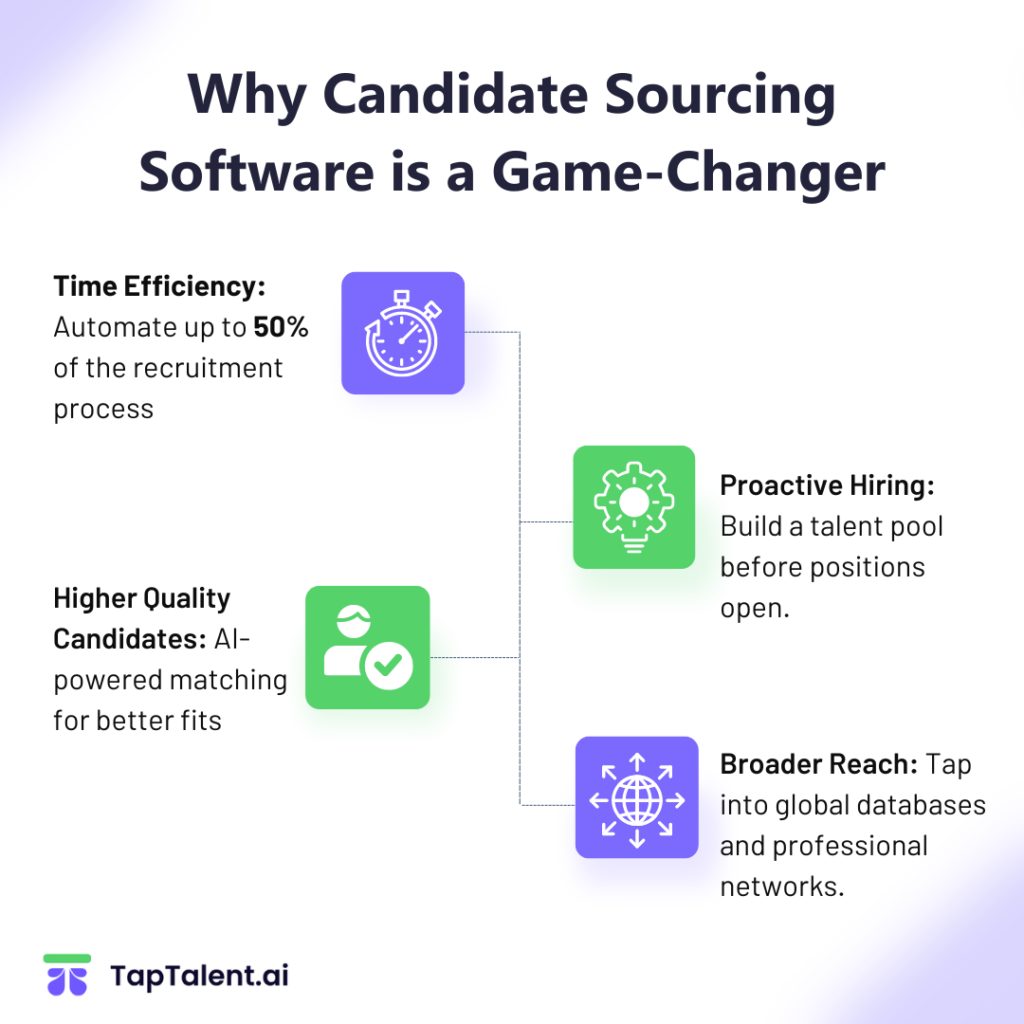Hiring the right talent can feel like chasing a moving target—just when you think you’ve found the perfect candidate, they’re already off the market. What if you had a smarter, more proactive way to stay ahead? That’s where candidate sourcing software steps in.
Instead of relying on outdated methods and scrambling to fill positions, you can use advanced tools to uncover top talent early, build relationships, and create a pipeline that works for you, not against you. In this guide, we’ll dive into how candidate sourcing software can transform your hiring strategy and help you consistently land the best talent.
Understanding Candidate Sourcing Software
Gone are the days of simply posting a job ad and waiting for the perfect candidate to magically appear. To gain a competitive edge, businesses must be proactive, strategic, and, most importantly, equipped with the right tools. This is exactly where candidate sourcing software comes into play.
Imagine having a super-powered search engine specifically designed to find the best job candidates. Essentially, that’s what candidate sourcing software does. Rather than passively waiting for applicants on traditional job boards, this specialized software enables you to actively search for top talent across a vast online landscape. It aggregates data from job boards, social media platforms like LinkedIn, and professional networks. Furthermore, it acts as a centralized platform for managing potential candidate profiles, allowing you to build targeted talent pools long before positions even open up.
But the advantages don’t stop there. The benefits of incorporating candidate sourcing software into your recruitment strategy are significant:
-
- Time is Money: Reduce the hours spent sifting through resumes by automating tedious tasks like screening and outreach. Imagine reclaiming 50% of your time to focus on building relationships with top candidates.
-
- Quality over Quantity: Move beyond basic keyword searches. Leverage AI-powered tools to pinpoint candidates who perfectly match your requirements, ensuring a better fit for your company culture and open roles.
-
- Proactive Pipeline Building: Don’t wait for the right candidate to stumble upon your job posting. Build a pool of qualified talent that’s ready when you need them, giving you a head start on filling critical positions.
For example, let’s say you’re a growing tech startup looking to hire a senior UX designer. Candidate sourcing software can help you identify experienced designers from top companies in your industry, even if they’re not actively looking for new opportunities. Or, imagine you’re a large corporation trying to fill a niche role that requires a very specific skill set. With this software, you can instantly access a global database of professionals and filter by skills, experience level, and even previous employers.
Candidate sourcing software isn’t just a tool, it’s a strategic advantage in the competitive war for talent.

Choosing the Right Software
Now that you understand the benefits of candidate sourcing software, let’s dive into how to find the perfect solution for your unique needs. It’s important to remember that not all software is created equal. Selecting the right tool for your team is crucial for maximizing ROI and achieving your hiring goals.
Here are some key factors to consider when evaluating candidate sourcing software:
-
- Ease of Use:
Time is precious, especially during the hiring process. Therefore, look for software with an intuitive interface that’s easy to navigate. For instance, ensure it accommodates team members with varying technical skills. Features such as drag-and-drop functionality, clear navigation menus, and helpful prompts can significantly save time and reduce the need for extensive training.
Moreover, consider the technical proficiency of your team. Consequently, opt for a solution that feels intuitive, even for those who aren’t tech-savvy.
-
- Integrations:
Your candidate sourcing software shouldn’t exist in a silo. Seamless integration with your existing HR systems, such as your Applicant Tracking System (ATS) and Customer Relationship Management (CRM) software, is vital. This prevents data silos and streamlines your workflow, ensuring a smooth transition of candidate information between platforms.
-
- Data Quality:
Accurate and up-to-date candidate information forms the foundation of successful hiring decisions. Therefore, ensure that the software you choose sources its data from reliable platforms and updates its databases regularly. This way, you guarantee that you’re reaching out to the right candidates with the right skills.
Additionally, don’t hesitate to ask software providers about their data sourcing methods and the frequency of their database updates.
-
- Customization Options:
Every organization has unique hiring needs. Look for software that allows for customization, enabling you to tailor your searches and workflows to match your specific requirements. This could include customizable search filters, candidate profile fields, and automated communication templates.
Think about your company’s unique hiring criteria and the roles you typically fill. Ensure the software allows you to tailor your searches accordingly.
-
- Scalability:As your business expands, your hiring needs will likely increase as well. Therefore, choose software that can scale with you, seamlessly accommodating larger candidate pools and additional users without compromising performance.
Additionally, consider your company’s growth trajectory. If you expect significant hiring in the coming years, prioritize software that provides scalable solutions. - Pricing and Support:
- Scalability:As your business expands, your hiring needs will likely increase as well. Therefore, choose software that can scale with you, seamlessly accommodating larger candidate pools and additional users without compromising performance.
Budget considerations are always important. Compare pricing plans from different platform, making sure you understand what features are included in each tier. Additionally, prioritize software that offers responsive and reliable customer support to assist you with any questions or technical difficulties.
Don’t be afraid to request a demo or trial period to test the software’s features and see if it’s a good fit for your team.
By carefully considering these factors, you can select the best candidate sourcing software to streamline your hiring process and build a winning talent pipeline.
Building Your Talent Pipeline with Candidate Sourcing Software
Finding the perfect candidate for a role can feel like searching for a needle in a haystack. Consequently, it becomes time-consuming and often frustrating, which can pull you away from other important tasks. However, that’s where candidate sourcing software comes into play – as your secret weapon, it enables you to build a pipeline brimming with top-tier talent.
This isn’t just about filling open roles; it’s about proactively building relationships with qualified professionals before you need them. That way, when you’re ready to hire, you’ve got a lineup of amazing candidates eager to jump in.
Here’s your step-by-step guide to mastering candidate sourcing and building a talent pipeline that fuels your company’s growth:
Step 1: Define Your Ideal Candidate Profile
Before you even think about keywords or search filters, you need a crystal-clear picture of your ideal candidate. And we’re not just talking about basic job descriptions here.
-
- Go Beyond Job Descriptions: Dig deeper into the personality traits, work cultural alignment, and soft skills that breed success within your company.
-
- Focus on Skills, Not Titles: Job titles can be misleading. Zero in on the core skills a candidate needs to excel. For example, instead of simply “Sourcer,” think “experience with Boolean search” or “expert in LinkedIn Recruiter.”
-
- Consider Future Needs: Don’t just focus on filling current openings. What skills will be in high demand for your company in the coming 6-12 months?
-
- Document Everything: Create a detailed “Ideal Candidate Persona” document for each key role you frequently hire for. This keeps everyone on the same page and ensures consistency in your search.
Actionable Tip: Open a new document right now and focus on the top 3 roles you hire for most often. For each one, jot down:
-
- Must-Have Skills
-
- Nice-to-Have Skills
-
- Cultural Fit Traits
For example, let’s say you’re looking for a Sales Development Representative (SDR). Instead of simply stating “must have 1 year of sales experience,” get granular:
-
- Must-Haves: Proven track record of exceeding quotas, excellent communication skills (written and verbal), experience with CRM software (like Salesforce).
-
- Nice-to-Haves: Knowledge of the HR tech industry, experience with cold outreach.
-
- Cultural Fit: Highly motivated, results-oriented, team player.
This detailed approach helps you target the right people from the get-go.
Step 2: Utilize Advanced Search Filters
You know who you’re looking for—now it’s time to find them! This is where TapTalent’s powerful search filters transform your talent sourcing efforts.
-
- Keyword Optimization: Go beyond the obvious keywords. Think like a candidate – what would they put on their profile? For a recruiting role, consider terms like “talent acquisition specialist,” “LinkedIn Recruiter expert,” and more.
-
- Boolean Search: Unleash the power of Boolean operators (AND, OR, NOT) to surgically refine your searches.
-
- Location Filters: Be as specific as you need, or utilize radius searches for broader reach.
-
- Experience Level: Easily target candidates with the right level of seniority for the role.
-
- Company Size/Industry: If relevant, narrow down your results by company size or industry for hyper-targeted sourcing.
-
- Save Your Searches: Save your most effective searches to run them again in the future — a massive time-saver for recurring hiring needs!
Actionable Tip: Log into your TapTalent account (or start a free trial) and put these tips into action:
-
- Experiment with Keywords: Don’t be afraid to try variations, synonyms, and even industry-specific jargon to see what yields the best results.
-
- Master Boolean Search: For example, “Sales Representative” AND “SaaS” AND “CRM” will give you a laser-focused list compared to just searching “Sales.”
- Save Your Best Searches: Your future self will thank you when you need to quickly find similar candidates down the line.
Step 3: Engage with Potential Candidates
You’ve unearthed some incredible potential candidates — now it’s time to make a connection! But be warned generic outreach gets lost in the black hole of the inbox.
-
- Personalization Is Key: First and foremost, demonstrate that you’ve actually taken the time to review their profile. Consequently, this approach helps you forge a connection right off the bat.
-
- Highlight Shared Connections: Moreover, if you share any mutual connections on LinkedIn, make sure to mention them! This not only increases your credibility but also builds a sense of familiarity.
-
- Focus on Value, Not Just the Job: What’s in it for the candidate? Therefore, don’t just talk about your company—discuss their potential growth, the exciting challenges they could tackle, and the impact they could make.
-
- Include a Call to Action: Finally, be crystal clear about the next step you want them to take. Should they reply to your message? Alternatively, should they schedule a quick call? Make it easy for them to engage.
Actionable Tip: Before you hit “send” on any outreach message, pause and ask yourself: “If I were this person, would I respond to this?”
-
- Ditch the Templates (Mostly): Use templates as a starting point, but personalize each message to resonate with the individual candidate.
-
- Highlight Something SPECIFIC From Their Profile: This proves you’ve done your homework and immediately sets you apart from generic outreach.
Let’s compare:
Bad Outreach: “Hey [Name], We’re hiring SDRs. Are you interested?”
Good Outreach: “Hi [Name], I came across your profile while looking for strong SDRs and was impressed by [mention something SPECIFIC, e.g., your experience at Company X or your success with cold outreach]. We’re building a team of ambitious SDRs at [Your Company] who are passionate about [Company Mission/Values]. If you’re open to exploring new opportunities, I’d love to connect!”
See the difference?
Step 4: Nurture Relationships Over Time
Building a robust talent pipeline is a marathon, not a sprint. It’s about cultivating relationships for the long haul.
-
- Embrace Candidate Relationship Management (CRM): By leveraging TapTalent’s built-in CRM features, you can effectively tag candidates, track interactions, and set reminders to follow up. Consequently, you will stay organized as your pipeline grows.
-
- Content Marketing Is Your Friend: Therefore, position yourself (and your company) as a thought leader by sharing relevant articles, industry news, and valuable insights with your network.
-
- Regular Check-Ins Are Crucial: Hence, don’t let promising candidates go cold. Instead, even a simple message every few weeks will keep you top-of-mind and strengthen the relationship.
Actionable Tip: Remember, building a talent pipeline is about building relationships for the long term.
-
- Use TapTalent’s CRM to Stay Organized: Tag candidates with skills, interests, or experience levels to quickly find them when the perfect opportunity arises.
-
- Be a Resource, Not Just a Recruiter: Share valuable content that your candidates will find genuinely interesting and helpful.
-
- Set Reminders to Follow Up: Don’t let great connections slip through the cracks!
The beauty of a talent pipeline? Even if someone isn’t a perfect fit right now, they might be ideal a few months down the line. By staying in touch, providing value, and nurturing those relationships, you’ll be the first person they contact when they’re ready for a change.
Stop scrambling to fill roles at the last minute. With the right candidate sourcing software and a strategic approach, you can build a talent pipeline that sets your company up for success today, tomorrow, and for years to come.
Best Practices for Effective Candidate Sourcing
While candidate sourcing software provides powerful tools, maximizing its impact requires a proactive and strategic approach. It’s not just about finding candidates; it’s about finding the right candidates and engaging them effectively.
Here’s how to level up your sourcing game:
-
- Personalize Your Outreach: Generic messages get lost in the noise. Take the time to research potential candidates and craft personalized messages that demonstrate genuine interest. Mention specific skills, experiences, or projects that caught your eye.
-
- TapTalent Tip: Use TapTalent’s unified smart inbox to keep track of all communication and ensure your messages are personalized and relevant to each candidate.
- TapTalent Tip: Use TapTalent’s unified smart inbox to keep track of all communication and ensure your messages are personalized and relevant to each candidate.
-
- Personalize Your Outreach: Generic messages get lost in the noise. Take the time to research potential candidates and craft personalized messages that demonstrate genuine interest. Mention specific skills, experiences, or projects that caught your eye.
-
- Go Beyond LinkedIn (But Use It Wisely): While LinkedIn is a valuable tool, explore other avenues like industry-specific forums, online communities, and professional networking events.
-
- TapTalent Tip: TapTalent’s global talent pool of 800 million+ professionals expands your reach beyond LinkedIn, giving you access to a wider range of potential candidates.
- TapTalent Tip: TapTalent’s global talent pool of 800 million+ professionals expands your reach beyond LinkedIn, giving you access to a wider range of potential candidates.
-
- Go Beyond LinkedIn (But Use It Wisely): While LinkedIn is a valuable tool, explore other avenues like industry-specific forums, online communities, and professional networking events.
-
- Build Relationships, Not Just Talent Pools: Candidate sourcing isn’t a one-time transaction. Nurture relationships with potential candidates over time. Share relevant content, engage in conversations, and stay top-of-mind.
-
- TapTalent Tip: Leverage TapTalent’s automated outreach campaigns to stay connected with candidates in your pipeline. Schedule regular email or WhatsApp messages to share company updates, industry insights, or relevant job openings.
- TapTalent Tip: Leverage TapTalent’s automated outreach campaigns to stay connected with candidates in your pipeline. Schedule regular email or WhatsApp messages to share company updates, industry insights, or relevant job openings.
-
- Build Relationships, Not Just Talent Pools: Candidate sourcing isn’t a one-time transaction. Nurture relationships with potential candidates over time. Share relevant content, engage in conversations, and stay top-of-mind.
-
- Showcase Your Employer Brand: Candidates are more likely to engage with companies that have a strong employer brand. Highlight your company culture, values, and mission in your outreach and on your career page.
- Showcase Your Employer Brand: Candidates are more likely to engage with companies that have a strong employer brand. Highlight your company culture, values, and mission in your outreach and on your career page.
-
- Leverage Employee Referrals: Encourage your employees to refer qualified candidates. Offer incentives and make it easy for them to share open positions with their networks.
- Leverage Employee Referrals: Encourage your employees to refer qualified candidates. Offer incentives and make it easy for them to share open positions with their networks.
-
- Measure Your Success: Track key metrics like sourcing channel effectiveness, time-to-fill, and candidate satisfaction to continuously improve your sourcing strategies.
-
- TapTalent Tip: Utilize TapTalent’s built-in analytics and reporting features to gain insights into your sourcing performance and identify areas for optimization.
-
- Measure Your Success: Track key metrics like sourcing channel effectiveness, time-to-fill, and candidate satisfaction to continuously improve your sourcing strategies.
By adopting these best practices and leveraging the power of TapTalent’s AI-driven platform, you will not only transform your candidate sourcing efforts but also build a robust talent pipeline. Consequently, you will stay ahead in the competition for top talent.
Conclusion
Building a robust talent pipeline is no longer a luxury but, rather, a necessity. Moreover, candidate sourcing software empowers businesses to proactively identify, engage, and nurture relationships with top talent, ensuring they are well-equipped to meet both current and future hiring needs. By automating tedious tasks, expanding your reach beyond traditional channels, and providing data-driven insights, candidate sourcing software effectively transforms your recruitment process. Consequently, this leads to reduced time-to-hire, significant cost savings, and a higher caliber of candidates entering your pipeline. So, are you ready to unlock the full potential of your recruitment strategy? If so, discover how TapTalent‘s AI-powered candidate sourcing platform can help you build a winning talent pipeline and gain a competitive edge. Visit our website or schedule a demo today to learn more!




